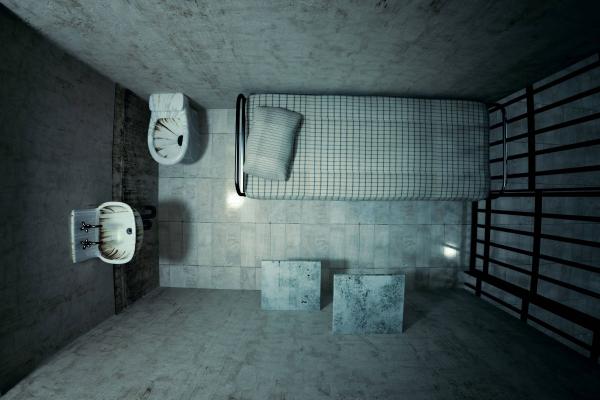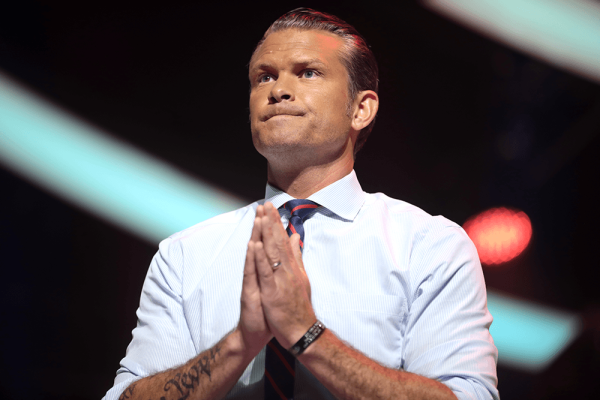The day before Adam Ward was slated to be executed, he sat in a visitation booth at the Allan B. Polunsky Unit in Livingston, Texas with Rev. DeAnna Golsan, a woman he had never met before.
During the months prior, the two — Golsan, a Texan pastor who believed in the merit and morality of the death penalty, and Ward, a man who was sentenced to death — had become unexpected pen pals after being connected by Ward’s mother, an attendee of Golsan’s church. Golsan felt she knew him well, yet, upon meeting Ward, she was forced to confront that the 33-year-old soft-spoken man who cared mostly about his mother was somehow slated for death.
The initial visit lasted an hour-and-half, at the end of which Ward told Golsan that he wanted to hold hands with someone if he was to be lethally injected the next day. Golsan, without hesitating, said yes.
It was to Golsan’s surprise that officials at Polunsky, where Ward was being held, would not permit Ward’s request. It was denied with no appeal. Golsan was told it would be a potential safety risk, as described in no-contact policies set by the Texas Department of Criminal Justice that bar any form of physical touch among death row inmates and their visitors. “Surely you understand that we cannot risk security just to give someone comfort,” said an official at the unit. Golsan did not understand, but her discomfort with Ward’s treatment was painted as nescience; it was her first experience with death row.
On the evening of March 22, 2016, Golsan walked into the execution chamber witness booth. Through a layer of glass, she watched Ward die for twelve minutes before he was pronounced dead at 6:34 p.m. She left the chamber with a feeling she couldn’t describe as anything else but hopelessness — knowing thousands had prayed for Ward’s clemency, and understanding it did nothing to save Ward’s life.
“I was trying to pray that night — wanting the strength that only God can give, and not being able to find it.”
A Miscarriage of Justice
Death row’s strict visitation policies have become a bedrock of institutional hurdles that death row chaplains like Goslan commonly face.
Among the policies is a 1984 U.S. Supreme Court case, Block v. Rutherford, in which a 6-3 ruling struck down a challenge from inmates in California that would have mandated prisons to allow contact visits between inmates and guests. The ruling cited physical contact as a potential safety risk, rather than a form of spiritual and emotional expression — a notion which many volunteer chaplains on death row commonly acknowledge as unjust, though often silently, to each other. To speak up, would be to risk their ability to access death row.
The Rutherford decision upheld the state-by-state justice system, which was largely established in the early 19th century as prison reform became a prevailing issue across post-Revolutionary War America. This system allows Texas and other, mostly conservative-leaning states — whose politicians and constituents welcome the death penalty — to aggressively enforce its non-contact visitation policy for death row inmates, dividing visits with thick plexiglass.
For Ward, the no-contact policy extended to his final days. He told Golsan in letters he was identified as a Catholic on paper, but she was unsure whether he really considered himself to be Catholic. Official documentation listed him as a nondenominational Christian, which could be why he was never anointed with oil or able to participate in the Eucharist before his execution — a common practice among Catholic death row inmates on the day of their death. Golsan asked for permission to offer him communion; she was again dismissed by officials who told her Ward wasn’t considered a “real Catholic,” so he didn’t qualify. Golsan saw it as a miscarriage of justice.
Shortly after Ward was pronounced dead, Golsan helped his mother make her way into Grace Baptist Church to see her son. It was here where prison officials rolled out Ward’s body so that his mother could see him. In touching her fingers to his body, an emotional burden swelled, and finally, burst. She collapsed into the arms of Golsan. It was the first time she had touched her son in more than 10 years. His body was cold.
Cruel and Unusual
If there is any spiritual comfort that death row chaplains can share between plexiglass, it is further sanctioned by solitary confinement — the illumination of which through public outcry and lawsuits have prompted a nationwide decrease in its prevalence. Recent years have seen nine states outlaw prolonged isolation for death row inmates. Despite these efforts, solitary confinement is still a looming reality for thousands of inmates.
Rev. Cari Willis, a volunteer death row chaplain in Virginia and North Carolina, refers to the people she meets as “the men on the row.” She takes out “death,” insisting there exists plenty of life. Through choked-back lament, Willis described the conditions that many on the row live in while enduring solitary confinement.
They are locked in single cells the size of parking spots for up to 23 hours a day and banned from recreational facilities used by other inmates. Solitary confinement starves them of what Willis calls a “human need to be heard.” She has responded to this with what she now calls her “listening ministry” on the row, in which Willis says she practices active listening — staying attentive to the worries and needs of the people she meets during her visitations.
In a 2015, a lawsuit in Virginia ended the state’s solitary confinement policy on grounds that it violated the “cruel and unusual” clause of the eighth amendment — though state prison officials have adamantly claimed the policy may be reinstated in the future. The emotional and spiritual progress that many on the row have made since the law was lifted has been promising; Willis has seen them over time become more loving and compassionate, encouraged by deepening spiritual experiences. Of one inmate in particular who Willis met with, she said, “He showed me facets of God that I would have never seen without his unique set of eyes. He loved me with a big love.”
The progress among those in Virginia’s row, then, creates a stark contrast to that of Texas, which still holds hundreds in solitary confinement for upwards of 22 hours a day. Volunteer chaplains in Texas have found that mental illnesses which are either exacerbated or imprinted on inmates in solitary confinement create a different, intangible, and oftentimes stronger hurdle for them as they attempt to tap into spiritual discovery. One chaplain at Polunsky quipped that they are treated as “less than human — caged like animals.” Golsan walked away from her time on death row with an understanding that, “the state has decided that these people are irredeemable.”
“They figure they have no faith, so why spend the time and resources that may give them closure and peace?” she said.
Restricting the chaplaincy further, the Polunsky Unit has reinforced its checks and oversight on chaplains with a rule that mandates that they be paired with guards during their allotted time onto the row.
Now, when chaplains walk through the corridors of death row and meet one-on-one with inmates, they have oversight. Conversations stick to small talk; no inmate wants to discuss spiritual matters with a guard within hearing distance for fear of exposing emotional weaknesses. In an attempt to provide a safer space for prisoners, a chapel service is held weekly at Polunsky, but inmates on the row are prohibited from attending; it would violate their 22-hour-a-day confinement — for two hours, inmates are allowed to shower and occasionally are permitted to go outside. Even if they were allowed out for chapel, there are not enough guards to escort them across the prison campus to the service.
The Injustice System
The shortage of prison guards is nationwide — mostly from low wages and poor hours, but in Texas, the lack of guards on the row has coalesced with heightened standards of supervision to cause a sporadic visitation timeframe for chaplains. Volunteer chaplains will show up at the Polunsky Unit only to be turned away when there aren’t enough guards to escort them around death row. Texas reported a 14 percent vacancy among its prison guards in 2018.
The byproduct of this is a decreased prison chaplaincy. Many inmates say they only see volunteer spiritual advisors during the holiday season, and non-Christian faith leaders are rare, if not completely removed. They say only Christian texts are available for request. Mass is limited to the night before an inmate’s execution and has previously been held in the Polunsky Unit’s barbershop over logistical burdens of moving inmates to the chapel. In a report by the Human Rights Clinic at the University of Texas School of Law, one former death row inmate, Christian Olsen, called the chaplain's department at Polunksy “a joke.”
There also exists a broad acceptance among U.S. prisons of “undue familiarity” clauses, which legally restricts chaplains from becoming too familiar with inmates or talking about intimate matters. These mandates are separate from those of the Prison Rape Elimination Act of 2003 — which instituted a “zero tolerance policy” of sexual assault in prisons by funding research and establishing a federal oversight commission — though similarly, the two rules seek to prevent personal relationships from forming between chaplains and visitors. What is considered “too intimate” can be a gray area. Volunteer chaplains have been told that asking for personal stories or about family could cross the line. If stronger oversight from guards and officials exists, chaplains may choose to avoid that line altogether.
Outside of death row, institutional frustrations among volunteer chaplains can turn to advocacy. A 2018 survey from Pew Research found a large and increasing amount of support for the death penalty among Christian groups. Seventy-three percent of white evangelicals support the death penalty; 61 percent among mainline Protestants; 53 among Catholics. Willis and Golsan, leaders in their churches, have found it difficult to denounce capital punishment from the pulpit without becoming a zealot in the eyes of their congregates — many of whom cite Matthew’s “eye for an eye” verse as theological backing for the death penalty. Still, Golsan and Willis believe a better understanding of the conditions of death row could penetrate that line of thinking; the lack of education in Christian circles about the legal side of the justice system, too, has found Willis discouraged.
“Whenever someone gets the death penalty, a lot of the people of faith that I talk to think they went through a perfect court case,” Willis said. “That’s not close to the truth. Eyes should be open to how our justice, or injustice system, really works.”
The institutional restrictions of the U.S. “injustice system,” over time, have seemingly become all but crushing for chaplains and spiritual advisors. There are moments they cannot forget: During multiple executions in Texas, family members have become inconsolably distraught in the witness booth — some physically removed by authorities. To attempt to stay even relatively calm during an execution, Willis turned her Bible to Psalm 46 and repeated to herself “Be still and know I am God.” Ward’s mother was not in the witness chamber; Golsan, still recovering from witnessing Ward’s execution, was the first one to tell her that her son was dead.
It was during the time with Ward’s mother at Grace Baptist, just moments after Ward’s execution, where Golsan said her emotions ran the deepest — her frustration with the systematic injustice, visceral. Through gasping sobs, Ward’s mother, still in the arms of Golsan, pleaded for answers. The question, “Was this God’s will?” has become a defining moment of Golsan’s ministry. Golsan, not quite knowing herself, responded with a quiet “no.”
“Somewhere along the way,” she said, “God was taken out of the equation.”
Got something to say about what you're reading? We value your feedback!




